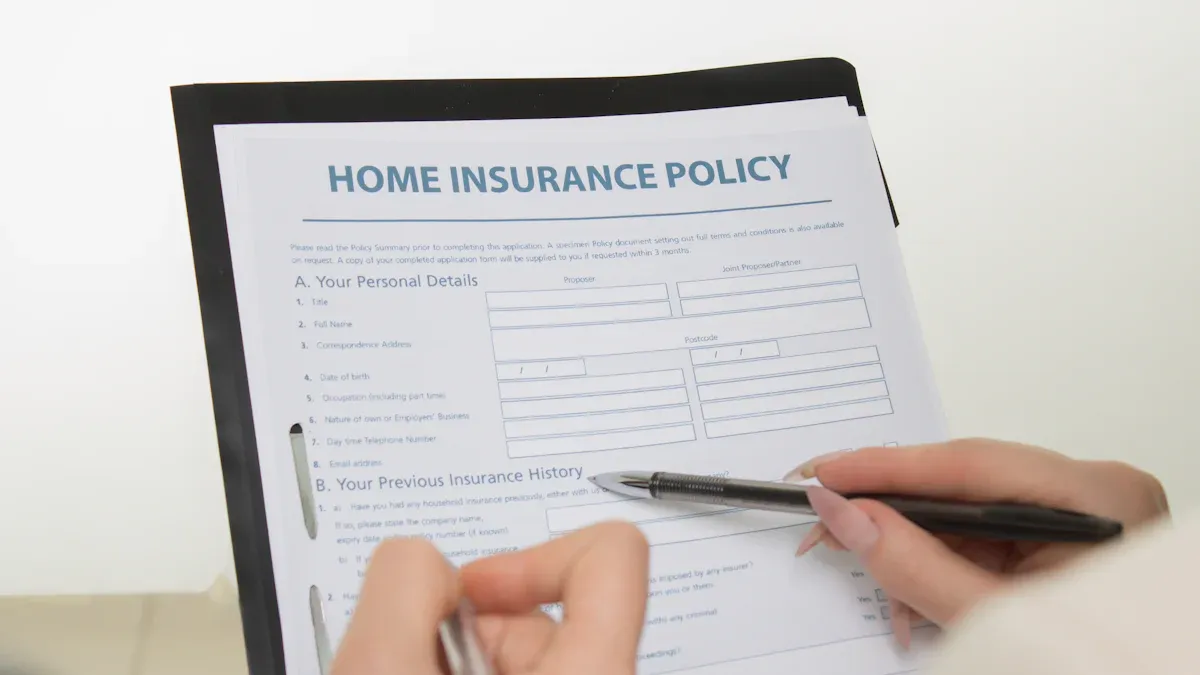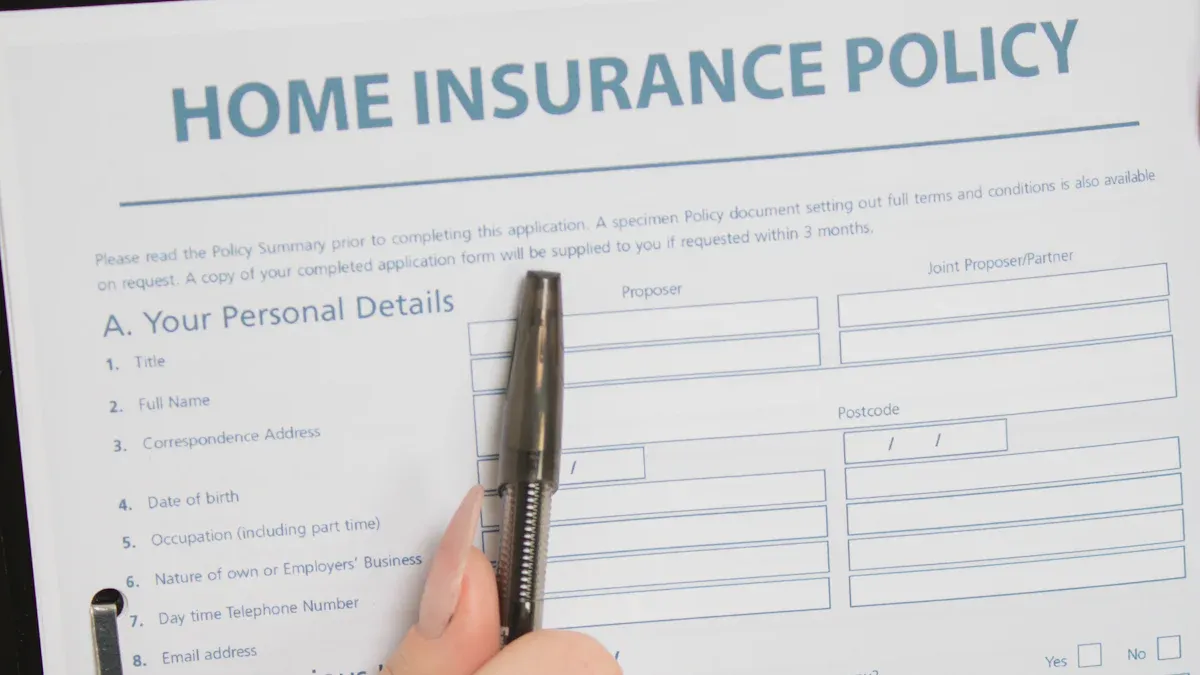
Extended replacement cost gives you more help if rebuilding costs go over your normal homeowners insurance. With this extra coverage, your home insurance raises your dwelling coverage by 25% to 50%. Many homeowners do not have enough insurance because building costs have gone up by 50% since 2017. New rules also make rebuilding cost more. If you live in a risky area or have new building rules, your homeowners policy may not pay for all the extra costs. Extended replacement cost is like a cushion, but it works best if you start with the right coverage. Think of it as a safety net, not a shortcut.
Tip: The Extended Replacement Cost Endorsement for Home Insurance: How it Works section shows how this extra coverage fits into your protection plan.
Key Takeaways
Extended replacement cost gives you 25% to 50% more coverage. It adds this to your home insurance. This helps pay if rebuilding costs go over your normal limit.
This coverage is a safety net for sudden price jumps after disasters. It only works if your first replacement cost matches the real rebuilding cost.
Standard coverage stops at your policy limit. Extended replacement cost pays above that limit. This gives you more protection if building costs go up.
The endorsement does not pay for upgrades or new building codes. It also does not cover some damages like floods and earthquakes. You should check your policy carefully.
Look at your coverage every year. Pick the right replacement cost first. Then add extended replacement cost for extra peace of mind and money safety.
What Is Extended Replacement Cost?

Key Features
You may ask why extended replacement cost matters. This coverage is added to your home insurance. It gives you more help if rebuilding costs go over your normal coverage. With extended replacement cost, your insurance pays more than your dwelling limit. It usually adds 25% to 50% extra. For example, if your policy covers $500,000 and you have 25% extended replacement cost, you could get up to $625,000 to rebuild after a disaster.
This extra help is useful when building costs rise fast. Things like not enough workers, higher material prices, or new rules can make costs go up. Many homeowners do not have enough insurance when this happens. Extended replacement cost helps pay for these surprise costs. This means you do not have to pay out of your own pocket. But this only works if you start with the right replacement cost. If your home is underinsured, extended replacement cost will not fix that.
Tip: Always make sure your replacement cost coverage matches what it would cost to rebuild your home today.
How It Differs from Standard Coverage
Standard replacement cost coverage pays to rebuild your home up to your dwelling limit. If rebuilding costs go over that limit, you must pay the rest. Extended replacement cost coverage gives you a safety net. It adds a set amount, like 25% or 50%, on top of your dwelling limit. This extra only helps if your rebuilding costs go past your first coverage.
Here’s a quick comparison:
Feature | Standard Replacement Cost | Extended Replacement Cost |
|---|---|---|
Pays up to dwelling limit | ✅ | ✅ |
Pays above dwelling limit | ❌ | ✅ (25%-50% extra) |
Helps with sudden cost spikes | ❌ | ✅ |
You pay a bit more for extended replacement cost, but you get peace of mind. Homeowners in places with fast-changing building costs or disaster risks find this coverage very helpful.
Extended Replacement Cost Endorsement for Home Insurance: How It Works
When It Applies
You may wonder when the extended replacement cost endorsement for home insurance: how it works is used. This endorsement helps if rebuilding your home costs more than your main coverage. After a big storm or fire, prices for workers and materials can rise fast. Your standard replacement cost coverage might not be enough. That is when the extended replacement cost endorsement for home insurance: how it works helps you. It gives you extra money to rebuild your home, even if prices have gone up since you got your policy.
Note: The endorsement only helps if your replacement cost is correct. If your home insurance is too low, the extra coverage will not fill the gap. Always check your coverage limits before you add this endorsement.
Percentage Increase Explained
The extended replacement cost endorsement for home insurance: how it works usually adds 10% to 25% more to your dwelling coverage. Some companies offer even bigger increases, sometimes up to 50%. This extra amount helps if rebuilding costs go up after a disaster. For example, if your home’s replacement cost is $400,000 and you pick a 25% endorsement, your coverage goes up to $500,000. This gives you a bigger safety net if you need to rebuild.
Insurance companies choose these percentages by looking at real rebuilding costs. They know that rebuilding can cost 30% to 50% more than the basic replacement cost. This is because you may need to pay for debris removal, special workers, or new building codes. The extended replacement cost endorsement for home insurance: how it works helps pay for these extra things, so you do not have to pay yourself.
Here’s a quick table to show how the percentage increase works:
Original Replacement Cost | Endorsement Percentage | New Coverage Limit |
|---|---|---|
$300,000 | 10% | $330,000 |
$300,000 | 25% | |
$300,000 | 50% | $450,000 |
How the Endorsement Works Step-by-Step
Let’s look at how the extended replacement cost endorsement for home insurance: how it works with an easy example. This will show you how the extra coverage helps if you need to rebuild.
You set your replacement cost coverage at $300,000.
You add a 25% extended replacement cost endorsement.
The endorsement gives you $75,000 more (25% of $300,000).
Your total coverage is now $375,000.
If a fire destroys your home and rebuilding costs $360,000, your policy pays all of it. Without the endorsement, you would have to pay $60,000 yourself.
Tip: Check your coverage limits every year. If you remodel or if building costs go up, update your replacement cost coverage. The extended replacement cost endorsement for home insurance: how it works is a cushion, not a fix for not enough insurance.
What Happens During a Claim?
If you need to file a claim, here is what happens:
You tell your insurer about the loss.
The insurance company sends someone to check the damage and see how much it costs to rebuild.
If rebuilding costs more than your main coverage, the extended replacement cost endorsement for home insurance: how it works adds the extra amount to your payout.
You get the money you need to rebuild, up to the new higher limit.
This process helps homeowners avoid paying a lot out of pocket when rebuilding costs go up after a disaster. But remember, the endorsement only works if your replacement cost coverage is set right. If your coverage is too low, you might still not have enough.
Alert: Some agents may say to lower your replacement cost and then add an endorsement to save money. This is risky. If your main coverage is too low, the endorsement will not help you rebuild fully. Always start with the right replacement cost.
The extended replacement cost endorsement for home insurance: how it works gives you peace of mind. You know you have a safety net if rebuilding costs suddenly rise. But it is not a shortcut. Make sure your replacement cost coverage is right, and use the endorsement as extra help, not as a replacement.
What’s Covered and Not Covered
Covered Losses
When you add extended replacement cost, you get extra help. This helps if you need to rebuild your home. The coverage helps when costs go over your main policy. For example, a wildfire or storm can damage your house. If prices for materials go up, this coverage pays the extra. It protects your home’s structure. You do not need to worry about sudden price jumps. This coverage is for rebuilding, not just small repairs. If you lose your whole house, you will be glad you have it.
Common Exclusions
Some things are not covered, even with extended replacement cost. You should know what is not included. Here are the most common things not covered:
Flood damage
Earthquake damage
Pest infestations like termites or rodents
Mold (unless caused by a covered event)
War or nuclear hazards
Damage from government action
Intentional damage or neglect
Normal wear and tear
Costs from new building codes or ordinances
Your policy will not pay for these losses. This is true even if you have the endorsement. Extended replacement cost has limits. It only pays up to a set percent above your policy.
Why It’s a Safety Net
You may wonder why it is called a safety net. This coverage gives extra help if costs go up after a disaster. It helps with surprise expenses. But you still need the right replacement cost. If your coverage is too low, you may pay a lot yourself. For example, if you insure your home for less than it costs to rebuild, the endorsement will not cover the gap. You need to plan and pick the right coverage. Extended replacement cost helps if costs rise, but it does not fix underinsurance.
Tip: Always check your homeowners policy. Make sure your coverage matches what it costs to rebuild your home today.
Extended Replacement Cost vs. Other Options

Standard Replacement Cost
Most home insurance policies have standard replacement cost. This coverage pays to rebuild your house if it is damaged or destroyed. The insurance company decides how much it costs to rebuild. If the cost is higher than your policy limit, you pay the rest. Standard replacement cost does not help if prices go up after a disaster. Many people choose this because it comes with the main policy and is simple to get.
Guaranteed Replacement Cost
Guaranteed replacement cost gives you the most coverage. With this, your insurance pays the full cost to rebuild, even if it is much more than your policy limit. There is no maximum amount. For example, if your limit is $250,000 but it costs $300,000 to rebuild, your insurance pays $300,000. This option costs more and is not offered for every home. Insurance companies may not give it to older homes or homes in risky places. It also does not pay for new building code upgrades.
Here’s a table to show how these choices compare:
Aspect | Standard Replacement Cost | Extended Replacement Cost | Guaranteed Replacement Cost |
|---|---|---|---|
Payout Limit | Up to policy limit | Policy limit + 25-30% | No limit |
Example | $200k limit, $250k rebuild = you pay $50k | $200k limit + 25% = $250k max | $250k rebuild, insurer pays all |
Availability | Most homes | Add-on, some policies | Not for all homes |
Cost | Base premium | Moderate increase | Highest premium |
Covers Code Upgrades | No | No | No |
Key Differences
You want to pick the right coverage for your home. Standard replacement cost gives basic help. Extended replacement cost adds extra, usually 25% to 30% more than your policy limit. Guaranteed replacement cost pays for all rebuilding, no matter how high the cost.
Extended replacement cost is a safety net, not a fix for not enough insurance. If your replacement cost is too low, the endorsement will not help. Some agents might tell you to lower your replacement cost and add the endorsement, but this is risky. Always start with the right replacement cost for your house.
State rules can change what coverage you can get. In some states, like California, insurance companies may not offer extended or guaranteed replacement cost because of strict rules and wildfire danger. If you live in a risky area, you may only get basic coverage from a state plan, which often does not have these endorsements.
Tip: Check your policy every year. Make sure your replacement cost matches what it would cost to rebuild your home now. Choose the coverage that helps you feel safe.
Is It Right for You?
Pros and Cons
You want to know if extended replacement cost fits your needs. Let’s look at the upsides and downsides so you can decide with confidence.
Pros:
You get extra protection if rebuilding costs go up after a disaster. The endorsement increases your replacement limit by 10% to 50%.
You lower the risk of paying out of pocket if your home costs more to rebuild than you expected.
You gain peace of mind, especially if you worry about sudden price jumps or live in a high-risk area.
Cons:
You pay a higher premium for this extra layer. The cost is more than standard replacement, so you need to weigh if it fits your budget.
Not every insurance company or state offers this option. You may need to check with your insurer to see if you can add it.
This endorsement only works if you set the right replacement value for your home. If you start with a low number, the extra percentage will not help you rebuild fully.
Note: Some agents may suggest lowering your replacement cost and adding this endorsement to save money. This is risky. If your replacement value is too low, the endorsement will not cover the gap.
Checklist for Homeowners
You want to make a smart choice. Here’s a checklist to help you decide if extended replacement cost is right for you:
Review your financial situation. Can you handle big out-of-pocket costs if rebuilding goes over your policy?
Think about your risk tolerance. If you want more security, extra replacement protection may help you sleep better.
Check if your home’s value or contents have changed. Did you remodel or buy new things?
Make sure you insure at least 80% of your home’s replacement value. This helps you get full reimbursement.
Balance your premium and deductible. Pick a deductible you can afford if you need to file a claim.
Don’t pick coverage based only on price. Look at the value and how much protection you get.
Review your policy every year. Update your replacement value if you make changes to your home.
🏡 Tip: Extended replacement cost gives you a safety net, but it does not replace careful planning. Start with the right replacement value, then use the endorsement for extra peace of mind.
Extended replacement cost coverage helps you if rebuilding costs go up after a disaster. You should remember a few things about it.
This coverage can pay more than your policy limit, sometimes up to 125%.
It keeps you from paying a lot of money yourself if costs rise.
Many people do not know how much it really costs to rebuild, so checking your policy often is important.
To keep your coverage current, follow these steps:
See if your coverage matches what it costs to rebuild in your area.
Ask your insurance agent about any changes.
You can feel good knowing you made smart choices to protect your home.
FAQ
What happens if I set my replacement cost too low?
If your replacement cost is too low, the endorsement will not help much. You might still have to pay a lot yourself. It is important to start with the right replacement cost for your home.
Does extended replacement cost cover upgrades or code changes?
No, this coverage does not pay for upgrades or new building codes. It only gives extra money to rebuild your home the way it was. You may need a different endorsement for code upgrades.
Can I add extended replacement cost to any home insurance policy?
Not every insurance company offers this option. Some companies or states do not allow it, especially in risky places. Always ask your agent if you can add this endorsement to your policy.
Is extended replacement cost the same as guaranteed replacement cost?
No, these are not the same. Extended replacement cost gives you a set percent above your limit. Guaranteed replacement cost pays whatever it takes to rebuild, with no limit. Guaranteed coverage usually costs more and is harder to get.
🏡 Tip: Always look over your policy with your agent. Make sure you have the right coverage for what you need.
